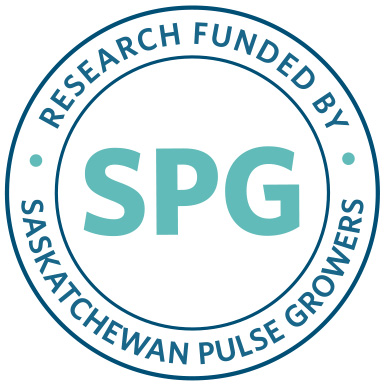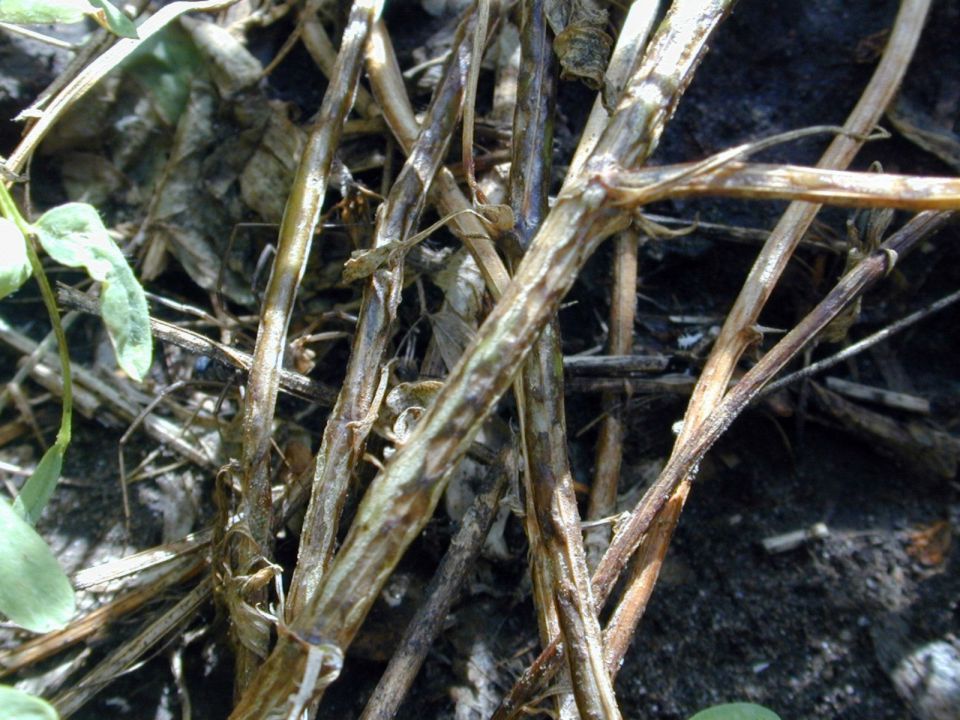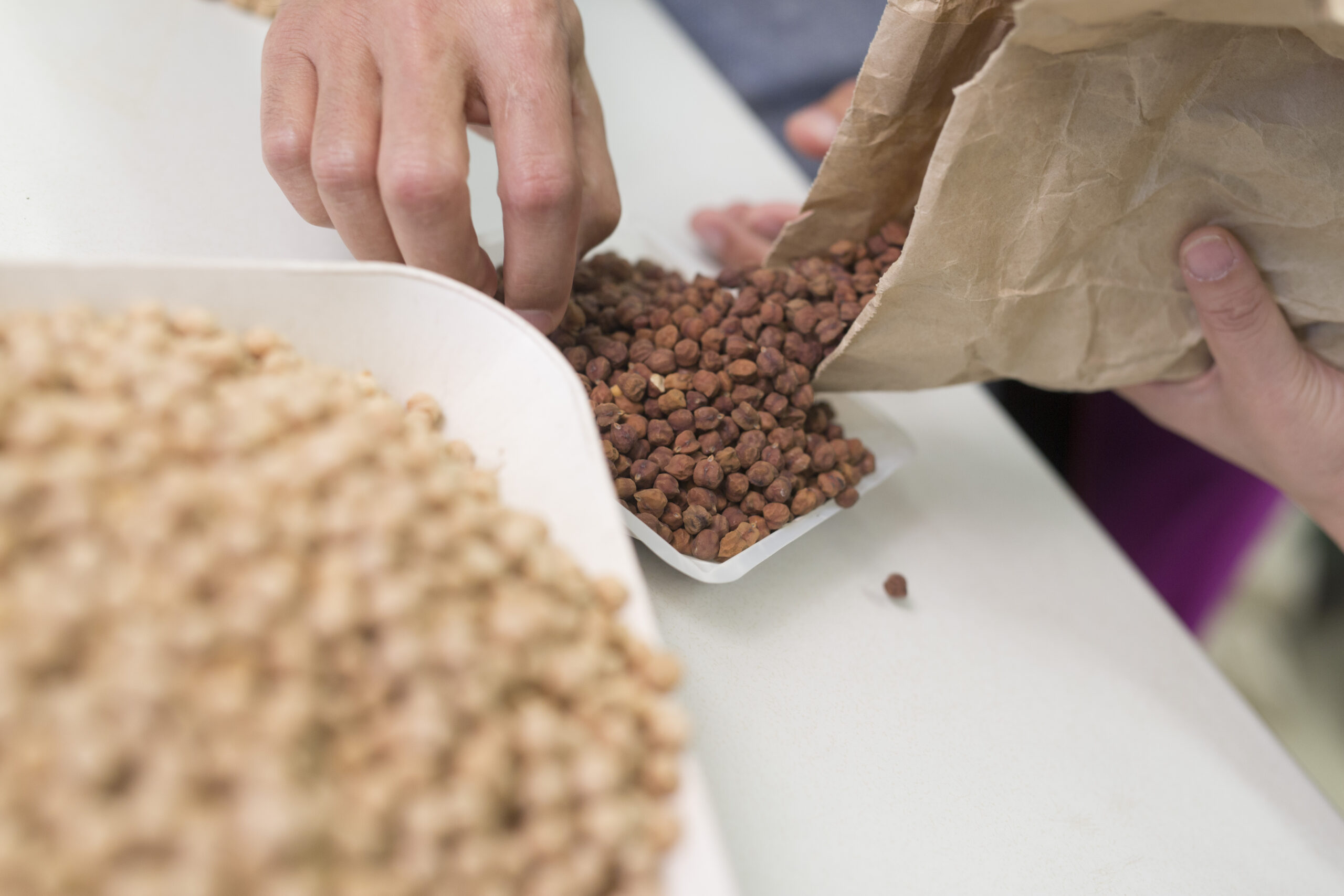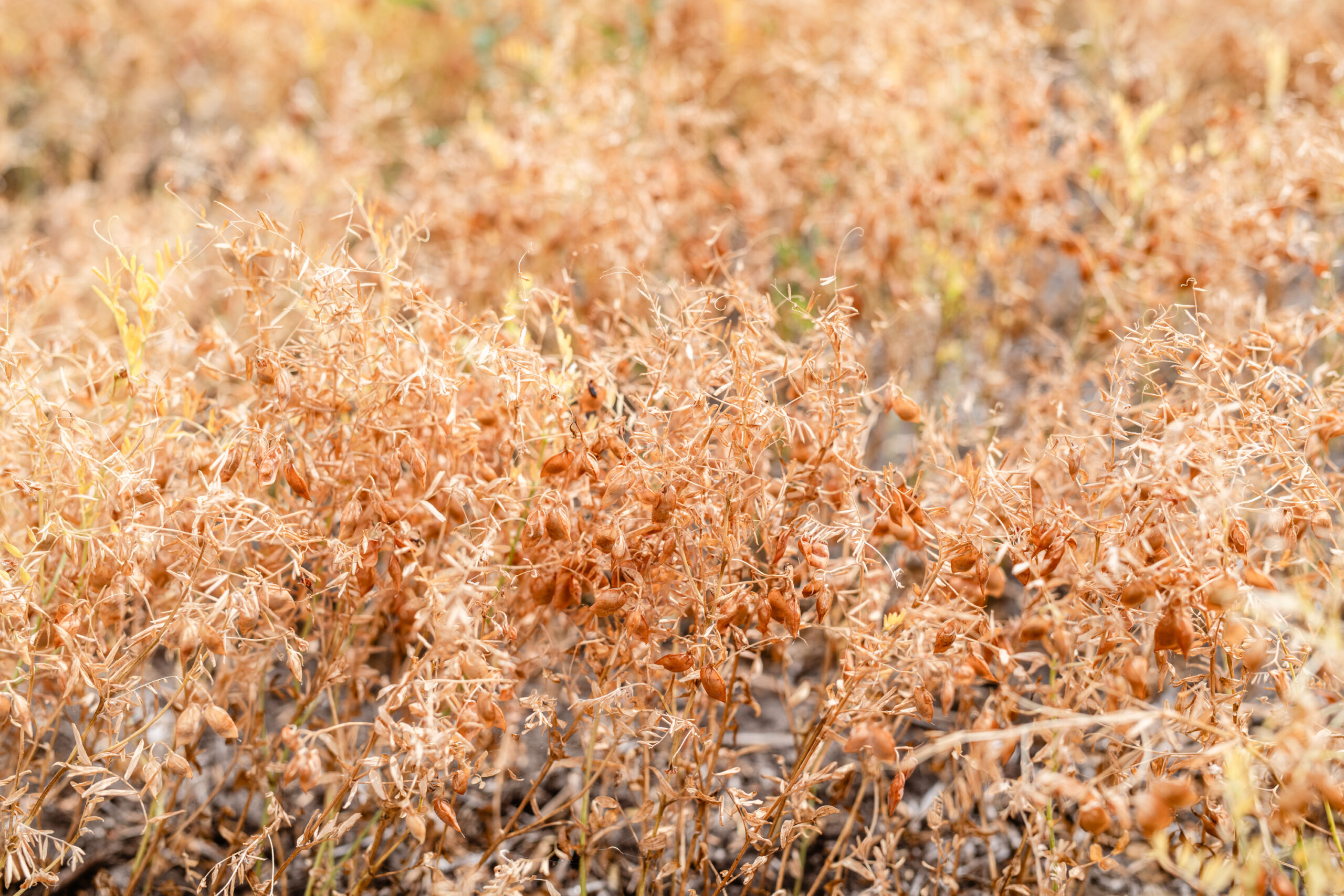Introduction
Lentil anthracnose is a fungal disease caused by the fungus Colletotrichum lentis. The disease is widespread in Saskatchewan and is the most common and potentially devastating disease of lentil in the province. C. lentis overwinters as microsclerotia on infected crop residue and can survive for up to four years. Rain splash causes these microsclerotia to release spores onto the lower parts of the plant. These spores germinate on the leaves and stems and form a specialized cushion-like structure called an appressorium, which drives a thin penetration peg into the plant. As the fungus grows within the plant, it eventually kills the infected tissue and sporulates again to continue to spread the disease throughout the crop canopy.
Growers rely heavily on fungicides to control the anthracnose in lentil. There are currently 21 fungicides registered in Saskatchewan for the control of anthracnose in lentils, and 14 of the 21 fungicides have a Group 11 (strobilurin) active as at least part of the formulation. Resistance to Group 11 fungicides is widespread globally and, perhaps unsurprisingly, Group 11 insensitivity in C. lentis isolates causing anthracnose was confirmed in Saskatchewan lentil fields in 2019. Additional information can be found in the Managing Anthracnose in Lentil or Fungicide Insensitivity in Pulse Crops factsheets.
A greenhouse study was established by the Saskatchewan Pulse Growers (SPG) in 2021 to test the efficacy of different fungicides in controlling Group 11 insensitive lentil anthracnose, conducted by Insight Plant Health, a third-party, independent lab in Saskatoon, SK.
Key Findings
- Any fungicide is better than no fungicide for lentil anthracnose, regardless of Group 11 sensitivity
- Multi-site contact actives and treatments that contain them offered the most reliable control against lentil anthracnose under the conditions tested in this study
- Growers should not rely on fungicide products containing only Group 11 actives to control lentil anthracnose in Saskatchewan
- Combination products that contain a Group 11 active should likely be combined with a contact active to provide better efficacy, this is especially true for Group 11 + Group 7 products
Materials and Methods
Fungicide treatments and fungal inoculation
Sixteen fungicide treatments, applied in accordance to label recommendations, were evaluated in this study. The fungicides were applied to 28 day old plants (small red lentil, CDC Impulse) upon reaching the 7–8 node stage. Fungicide treatments were applied preventatively, and prior to fungal inoculation, in a spray chamber calibrated to deliver the suggested rates in a single pass at 40 PSI through a Teejet® 8002 spray nozzle. Each fungicide treatment was applied to five plants. Lentil plants inoculated with sensitive C. lentis isolates blends and lentil plants inoculated with insensitive C. lentis isolates blends, which received no fungicide treatments, were considered the positive control (No Fungicide – UTC). Lentil plants that were neither inoculated with any strain of C. lentis nor treated with a fungicide were established as the negative control (Healthy Plant). There were 175 plants per experiment and the experiment was repeated once.
Table 1. Description of fungicide and control treatments
| Treatment1 | Manufacturer | Group | Active Ingredient | GAI2 (g/ac) | Label Rate (ml/ac) | Water Volume (USG/ac) |
|---|---|---|---|---|---|---|
| Healthy Plant3 | N/A | N/A | N/A | N/A | N/A | N/A |
| No Fungicide (UTC)4 | N/A | N/A | N/A | N/A | N/A | N/A |
| Headline® EC | BASF | 11 | pyraclostrobin | 40.0 | 160.0 | 10 |
| Quadris® | Syngenta | 11 | azoxystrobin | 50.5 | 202.0 | 10 |
| Trifloxystrobin | Bayer | 11 | trifloxystrobin | 53.4 | 356.0 | 10 |
| Bravo® ZN | Syngenta | M5 | chlorothalonil | 500.0 | 1000.0 | 24 |
| Manzate® Max | UPL | M3 | mancozeb | 681.6 | 1420.0 | 10 |
| Proline® 480 SC- LR | Bayer | 3 | prothioconazole | 61.4 | 128.0 | 10 |
| Proline® 480 SC- HR | Bayer | 3 | prothioconazole | 81.6 | 170.0 | 10 |
| Cotegra®- LR | BASF | 3 | prothioconazole | 36.0 | 240.0 | 10 |
| 7 | boscalid | 60.0 | ||||
| Cotegra®- LR | BASF | 3 | prothioconazole | 42.0 | 280.0 | 10 |
| 7 | boscalid | 70.0 | ||||
| Proline® Gold | Bayer | 3 | prothioconazole | 60.6 | 303.0 | 10 |
| 7 | fluopyram | 60.6 | ||||
| Delaro® 325 SC | Bayer | 3 | prothioconazole | 62.3 | 356.0 | 10 |
| 11 | trifloxystrobin | 53.4 | ||||
| F1375ab | UPL | 3 | tetrazonazole | 44.5 | 222.7 | 10 |
| 11 | fluaxastrobin | 44.5 | 222.7 | |||
| Elatus® | Syngenta | 7 | benzovindiflupr | 20.0 | 200.0 | 10 |
| 11 | azoxystrobin | 50.0 | 200.0 | |||
| Dyax® | BASF | 7 | fluxapyroxad | 40.0 | 160.0 | 10 |
| 11 | pyraclostrobin | 40.0 | ||||
| Bravo® Zn + Elatus® | Syngenta | M5 | chlorothalonil | 500.0 | 1000.0 | 24 |
| 7 | benzovindiflupr | 20.0 | 200.0 | |||
| 11 | azoxystrobin | 50.0 | 200.0 | |||
| Miravis® Neo 300 SE | Syngenta | 3 | propiconazole | 50.5 | 404.0 | 10 |
| 7 | pydiflumetofen | 30.3 | ||||
| 11 | azoxystrobin | 40.4 |
1 Proline® and Cotegra® fungicides are registered at two rates; LR= low rate, HR=high rate
2 GAI = grams of active ingredient
3 Healthy Plant= negative control. This treatment was not inoculated with C. lentis and did not receive any fungicide treatment.
4 No Fungicide (UTC) = postive control. Plants were inoculated with one of either insensitive or sensitive C. lentis isosolate blends but did not receive any fungicide treatment.
Six C. lentis isolates—three insensitive and three sensitive—were used in this experiment. All six isolates were tested for their ability to grow on pyraclostrobin and trifloxystrobin (Group 11, strobilurin), and were confirmed as either insensitive isolates or sensitive isolates using molecular analysis to identify the mutation (G143A) indicative of strobilurin insensitivity.
Plants were inoculated 24 hours (day 29) after fungicide application with 5×105 spores per plant. Spores were a blend of either three sensitive or three insensitive isolates. Inoculated plants were then placed in a tray containing a litre of water, and covered with a clear plastic dome for 24 hours to increase the humidity and encourage spore germination.
Disease ratings
The lentil plants were rated for disease symptoms at one, three and five weeks after inoculation using the 0–5 scale developed for anthracnose field surveys by Dr. Michelle Hubbard, Research Scientist with Agriculture and Agri-Food Canada. Because the plants were inoculated by spraying, rather than by natural infestation, the plant part affected by the disease did not change the rating. Each plant was rated separately by two people and the ratings were averaged. At the end of the experiment, the aboveground parts of the plants were harvested, dried at 40°C for five days, and weighed to determine any potential differences in lentil biomass production.
Table 2. Description of rating scale used to assess anthracnose severity
| Rating | Rating Scale | Description |
|---|---|---|
| 0 | 0% | No lesions/symptoms. |
| 1 | <5% | Plant area diseased (lower canopy). A few superficial lesions at stem base. |
| 2 | 5‒25% | Stems and leaves affected in the 10 plants being rated (lower canopy). Lesions, some leaf drop. |
| 3 | 25‒50% | Stems and leaves affected in the 10 plants being rated (lower and mid canopy). Lesions and leaf drop. |
| 4 | 50‒75% | Stems and leaves affected in the 10 plants being rated (lower, mid and upper canopy). Lesions, leaf drop, shoot die-back). |
| 5 | >75% | Stems and leaves affected in the 10 plants being rated (lower, mid and upper canopy). Lesions, leaf drop, severe shoot die-back). |
Results and Discussion

The results of this testing reflect the efficacy of the products tested in the manner in which they were tested. Because the plants were sprayed once and inoculated once, they showed a snapshot of anthracnose control but did not entirely reflect in-field conditions. For example, secondary infection and spread by rain splash would not be seen in this trial, and continual inoculation from sporulating lesions and stubble residue would also not occur. As a result, none of the lentil plants progressed to complete death or earned a rating beyond four (0–5 scale).
Single active strobilurin fungicides
Lentil plants that received single active strobilurin fungicides treatments (Headline® EC, Quadris®, Trifloxystrobin) showed considerable symptom development following treatment with the Group 11 insensitive isolates compared to treatment with Group 11 sensitive isolates.
Fungicide treatments containing only Group 11 active ingredients perform similarly to the untreated control against the Group 11 insensitive C. lentis isolates. Furthermore, all three of these fungicide treatments were statistically inferior at controlling Group 11 insensitive anthracnose relative to Group 11 sensitive anthracnose.


11-insensitive (light green) and Group 11-insensitive C. lentis isolates across all inoculation intervals and replicates. Significant differences between control of insensitive and sensitive strains of anthracnose are denoted by *.
Combination and multi-site fungicides
Combination products that contain a Group 11 active with a Group 7 (Dyax® and Elatus®) or Group 3 active (Delaro 325® SC and F1375ab) generally performed better than those only containing a Group 11 active. However, their ability to control lentil anthracnose was imperfect and they performed less effectively against the disease caused by Group 11 insensitive isolates. For Dyax® and Elatus®, there was a significant difference (p=5.07e-05 and p=2.20e-07, respectively) between the control of Group 11 sensitive vs. insensitive anthracnose, but not for Delaro® 325 SC (p=0.625) or F1375ab (p=0.907), which contain a Group 3 instead of a Group 7 in combination with a Group 11.
Lentil anthracnose was also not entirely controlled by Group 3 or Group 3+7 fungicide treatments, with certain treatments appearing to perform worse against Group 11 sensitive strains compared to insensitive strains. Plants treated with two of the fungicides containing prothioconazole (Proline® 480 SC and Cotegra®) showed symptom development in all phases of the of the trials but symptom severity was not significantly different than the untreated control in only the Group 11 sensitive inoculated plants.

Products containing lower rates of prothioconazole had improved disease control on the Group 11 insensitive isolates.

The best performing fungicide treatments, in terms of the lowest ratings overall, were the contact products Bravo Zn (and Bravo® Zn + Elatus®) and Manzate® Max, containing the multi-site active ingredients chlorothalonil or mancozeb, respectively. Fungicides that act on multiple sites (Group M) have been identified by the Fungicide Resistance Action Committee (FRAC) as having a low insensitivity risk because the pathogen would have to make multiple mutations in order to confer resistance. Such a number of different mutations is rarely occurring in nature and far less likely than actives with a single target site (Group 3, Group 7, and Group 11). As such, when applied at adequate water volumes such as those used in this study, Group M contact fungicides can be an effective tool against lentil anthracnose even in the presence of insensitive strains. It is important to note that the conditions of this experiment were especially favourable to anthracnose control by a contact active in absence of secondary infection and continued inoculum spread.
Although fungicide treatments offered varying levels of control to sensitive and insensitive C. lentis isolates when evaluated at one, three, and five weeks post-inoculation, all fungicide treatments controlled lentil anthracnose better than no fungicide application when disease ratings were combined across all plants, replicates, timings, and isolate strain. As a general pattern, fungicide treatments containing multi-site active ingredients were the strongest at controlling lentil anthracnose, followed by Group 11 combination products containing a Group 3 active and then those containing a Group 7 product. With certain exception, fungicides that did not contain a Group 11 active were relatively poor at controlling lentil anthracnose, but fungicides containing only Group 11 active ingredients were generally the worst, offering only a slight improvement over no fungicide at all.
Conclusions
Results of this greenhouse study demonstrate that Group 11 actives cannot be used on their own for control of lentil anthracnose and that growers should also use caution with combination products containing a Group 11 and Group 7 active. The addition of a contact active like chlorothalonil or mancozeb together with a systemic product likely provides the best protection against Group 11-insensitive lentil anthracnose in Saskatchewan.

Fungicide insensitivity in colletotrichum lentis, the causal agent of anthracnose of lentil
Dr. Michelle Hubbard Agriculture & Agri-Food Canada



